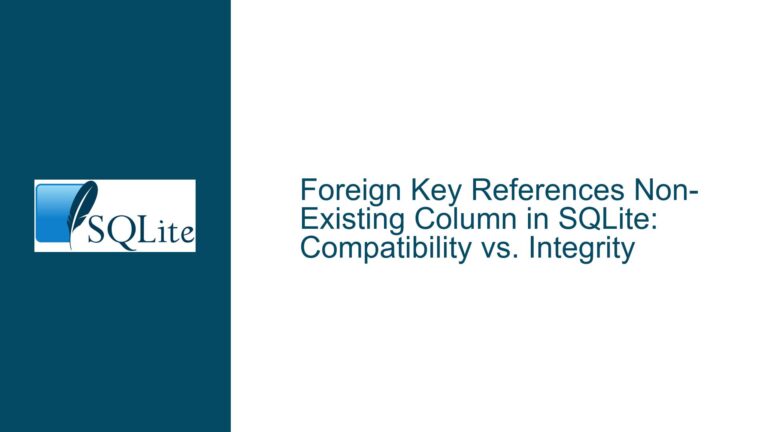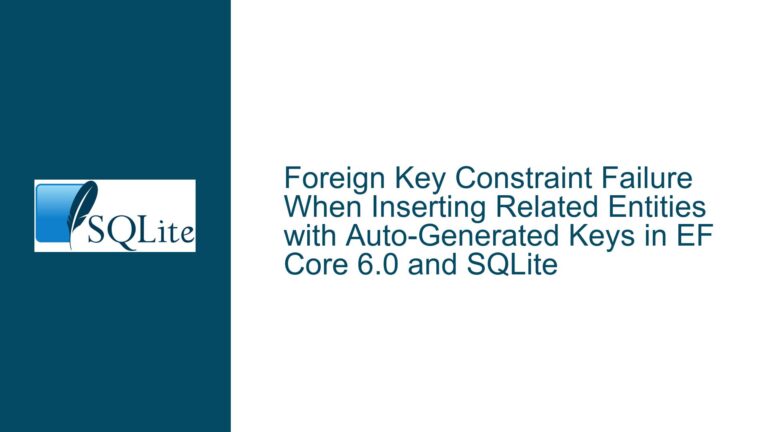and Resolving WAL Mode Visibility Issues in SQLite
Issue Overview: WAL Mode and Read Visibility in SQLite
When using SQLite in Write-Ahead Logging (WAL) mode, one of the most common issues developers encounter is the lack of visibility of recently written data on read connections. This issue is particularly perplexing because WAL mode is designed to allow concurrent reads and writes, with readers seeing a consistent snapshot of the database as it existed at the start of their read transaction. However, in some cases, read connections fail to see changes made by write connections, even when the write operations have been committed.
The core of the problem lies in the interaction between the WAL mechanism, SQLite’s transaction management, and how prepared statements are handled. In WAL mode, SQLite maintains a separate log file (the WAL file) where changes are recorded before being applied to the main database file. Readers can access the database without blocking writers, and writers can append changes to the WAL without blocking readers. However, this concurrency model relies on proper transaction handling and the correct use of prepared statements.
In the scenario described, the HTTP server application opens one write connection and one read connection, both configured with the same PRAGMA settings: journal_mode=WAL, synchronous=NORMAL, and busy_timeout=1000. The write connection successfully inserts a row, but the read connection does not see the newly inserted data. This behavior is counterintuitive, especially since WAL mode is supposed to provide consistent read visibility.
The issue becomes more complex when considering the behavior of the wal_checkpoint command. When executed, the wal_checkpoint command takes an unusually long time (up to the busy_timeout duration) and exits without an error. This behavior suggests that there is some form of contention or blocking occurring within the database, which is preventing the checkpoint operation from completing promptly. Additionally, the fact that creating a new read connection allows the changes to be visible indicates that the problem is related to the state of the existing read connection rather than a fundamental issue with the WAL mechanism itself.
Possible Causes: Transaction Management and Prepared Statements
The root cause of the visibility issue in this scenario is related to how transactions and prepared statements are managed in the read connection. Specifically, the problem arises from the way prepared statements are cached and reused without properly finalizing or resetting them. This mismanagement leads to open transactions that prevent the read connection from seeing the latest changes made by the write connection.
In SQLite, a prepared statement is a precompiled SQL command that can be executed multiple times with different parameters. When a prepared statement is executed, it may implicitly begin a transaction if one is not already active. If the prepared statement is not properly finalized or reset after execution, the transaction remains open, which can lead to several issues, including the inability to see new changes made by other connections.
In the described scenario, the application caches prepared statements in a hash map, reusing them instead of finalizing them after each use. While this approach can improve performance by reducing the overhead of repeatedly preparing the same SQL statements, it can also lead to unintended side effects if the statements are not managed correctly. Specifically, if a prepared statement is not reset after execution, it may keep a transaction open, which can prevent the read connection from seeing changes made by the write connection.
The behavior of the wal_checkpoint command further supports this diagnosis. When a read connection has an open transaction, it holds a read lock on the database, which can prevent the checkpoint operation from completing. This is why the wal_checkpoint command takes a long time to execute and eventually exits without an error. The read lock held by the open transaction prevents the checkpoint from acquiring the necessary locks to proceed, leading to the observed behavior.
Additionally, the fact that creating a new read connection allows the changes to be visible further confirms that the issue is related to the state of the existing read connection. A new read connection starts with a fresh transaction state, allowing it to see the latest changes in the WAL file. In contrast, the existing read connection, with its open transaction, is stuck viewing an older snapshot of the database.
Troubleshooting Steps, Solutions & Fixes: Properly Managing Transactions and Prepared Statements
To resolve the visibility issue in WAL mode, it is essential to ensure that transactions and prepared statements are managed correctly. The following steps outline the necessary changes to the application code to address the problem:
Finalize Prepared Statements After Use: The most critical change is to ensure that prepared statements are properly finalized after each use. Finalizing a prepared statement releases any resources associated with it, including any open transactions. This allows the read connection to see the latest changes made by the write connection. In the application code, this means calling the
.Finalizemethod on the prepared statement after it has been executed, rather than caching it in a hash map.Reset Prepared Statements Before Reuse: If the application must cache prepared statements for performance reasons, it is essential to reset them before reuse. Resetting a prepared statement clears any bound parameters and resets its state, allowing it to be executed again without keeping an open transaction. In the application code, this means calling the
.Resetmethod on the prepared statement after each execution, before returning it to the cache.Explicitly Manage Transactions: To avoid implicit transactions caused by prepared statements, the application should explicitly manage transactions. This means beginning a transaction explicitly before executing a series of SQL commands and committing or rolling back the transaction as needed. Explicit transaction management ensures that transactions are properly closed, preventing them from remaining open and blocking other operations.
Monitor and Debug Transaction State: To diagnose and prevent similar issues in the future, the application should include logging or monitoring to track the state of transactions and prepared statements. This can help identify situations where transactions are left open or prepared statements are not properly finalized or reset. By monitoring the transaction state, the application can detect and address issues before they lead to visibility problems.
Optimize Checkpointing: While the immediate issue is related to transaction management, it is also important to optimize the checkpointing process to ensure that the WAL file is periodically flushed to the main database file. This can be done by configuring the
wal_autocheckpointsetting or manually executing thewal_checkpointcommand at appropriate intervals. Proper checkpointing helps maintain database performance and prevents the WAL file from growing excessively large.
By implementing these changes, the application can ensure that read connections see the latest changes made by write connections, even in WAL mode. Properly managing transactions and prepared statements is key to avoiding visibility issues and maintaining the performance and reliability of the database.
In conclusion, the visibility issue in WAL mode is a common challenge that arises from the interaction between SQLite’s transaction management and the use of prepared statements. By understanding the underlying mechanisms and implementing the necessary changes to manage transactions and prepared statements correctly, developers can ensure that their applications work as expected in WAL mode. This not only resolves the immediate issue but also improves the overall robustness and performance of the database.






